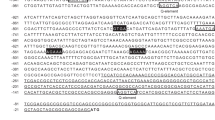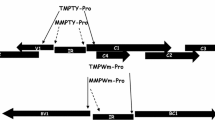Summary
As part of our research to develop an alternative system for the transformation of recalcitrant plant species we investigated the use of the male gametophyte as a transformation vector. Therefore the activity of four different promoters (CaMV 35S, LAT52, chiA PA2 and TR2') was analyzed in pollen of a dicot (Nicotiana glutinosa) and a monocot (Lilium longiflorum) plant species. Gene constructs in which the ß-glucuronidase (GUS) gene was placed under the control of these promoters were introduced in pollen using a particle delivery system. No activity of the Cauliflower Mosaic Virus (CaMV) 35S promoter was detected in pollen of both N. glutinosa and L. longiflorum. The promoter of the tomato flower-specific LAT52 gene was highly active in N. glutinosa pollen but remained silent in L. longiflorum pollen. A similar expression pattern was observed for the pollen-specific Chalcone Flavanone Isomerase chiA PA2 promoter originally isolated from petunia. The TR2′ mannopine synthase promoter of Agrobacterium tumefaciens, however, was active in pollen from Solanaceous species and also in pollen from the monocot L. longiflorum. This suggests that the TR2' promoter is active in vegetative and sporogenous tissues of dicot and monocot plant species.
Similar content being viewed by others
Abbreviations
- ADH1 :
-
Alcohol Dehydrogenase 1
- A. tumefaciens :
-
Agrobacterium tumefaciens
- CaMV :
-
Cauliflower Mosaic Virus
- ChiA :
-
Chalcone Flavanone Isomerase A
- L. longiflorum :
-
Lilium longiflorum
- N. glutinosa:
-
Nicotiana glutinosa
- Nos:
-
Nopaline Synthase
- N. tabacum :
-
Nicotiana tabacum
References
Bradford MM (1976) A rapid and sensitive method for the quantification of microgram quantities of protein utilizing the principle of protein dye binding. Anal. Biochem. 72:248–254.
Brewbaker JL, Kwack BH (1963) The essential role of calcium ion in pollen germination and pollen tube growth. Am. J. of Bot. 50:859–865.
Bytebier B, Deboeck F, De Greve H, Van Montagu M (1987) T-DNA organization in tumor cultures and transgenic plants of the monocotyledon Asparagus officinalis. Proc. Natl. Am. Sc. USA 84:5345–5349.
Chen WH, Gartland KMA, Davey MR, Sotak R, Gartland JS, Mulligan BJ, Power JB, Cocking EC (1987) Transformation of sugarcane protoplasts by direct uptake of a selectable chimeric gene. Plant Cell Rep. 6:297–301.
Datta SK, Datta K, Potrykus I (1990a) Fertile Indica rice plants regenerated from protoplasts isolated from microspore derived suspensions. Plant Cell Rep. 9:253–256.
Datta SK, Peterhans A, Datta K, Potrykus I (1990b) Genetically engineered fertile Indica-rice recovered from protoplasts. Bio/Technology 8:736–740.
Fromm M, Taylor LP, Walbot V (1986) Stable transformation of maize after electroporation. Nature 319:791–793.
Heslop-Harrison J, Heslop-Harrison Y (1970) Evaluation of pollen viability by induced fluorescence: intracellular hydrolysis of fluorescein diacetate. Stain Tech. 45:115–120.
Horsch RB, Fry JE, Hoffmann NL, Wallroth M, Eicholtz D, Rogers SG, Fraley RT (1985) A simple and general method for transfering genes into plants. Science 227:1229–1231.
Jefferson RA, Kavanagh TA, Bevan MW (1987) GUS fusions: ß-glucuronidase as a sensitive and versatile gene fusion marker in higher plants. EMBO J. 6:3901–3907.
Klein TM, Wolf ED, Wu R, Sanford JC (1987) High-velocity microprojectiles for delivering nucleic acids into living cells. Nature 327:70–73.
Koncz C, Mayerhofer R, Koncz-Kalman Z, Nawrath C, Reiss B, Redei GP, Schell J (1990) Isolation of a gene encoding a novel chloroplast protein by T-DNA tagging in Arabidopsis thaliana. EMBO J. 9:1337–1346.
Koornneef M, Hanhart CJ, Martinelli L (1987) A genetic analysis of cell culture traits in tomato. Theor. Appl. Genet. 74:633–641.
Langridge WHR, Fitzgerald KJ, Koncz C, Shell J, Szalay AA (1989) Dual promoter of Agrobacterium tumefaciens mannopine synthase genes is regulated by plant growth hormones. Proc. Natl. Am. Sc. USA 86:3219–3223.
Meijer EGM, Schilperoort RA, Rueb S, Van Os-Ruygrok PE, Hensgens LAM (1991) Transgenic rice cell lines and plants: expression of transfered chimeric genes. Plant Mol. Biol. 16:807–820.
Plegt LM, Bino RJ (1989) ß-Glucuronidase activity during development of the male gametophyte from transgenic and nontransgenic plants. Mol. Gen. Genet. 216:321–327.
Potrykus I, Saul MW, Petruska J, Paszkowski J, Shillito RD (1985) Direct gene transfer to cells of a gramineous monocot. Mol. Gen. Genet. 199:167–177.
Reggiardo MI, Arana JL, Orsaria LM, Permingeat HR, Spitteler MA, Vallejos RH (1991) Transient transformation of maize tissues by microparticle bombardment. Plant Sc. 75:237–243.
Saito K, Yamazaki M, Kaneko H, Murakoshi I, Fukuda Y, Van Montagu M (1991) Tissue-specific and stress-enhancing expression of the TR promoter for mannopine synthase in transgenic medical plants. Planta 184:40–46.
Shimamoto K, Terada R, Izawa T, Fujimoto H (1989) Fertile transgenic rice plants regenerated from transformed protoplasts. Nature 338:274–276.
Spencer TM, Gordon-Kamm WJ, Daines RJ, Start WG, Lemaux PG (1990) Bialaphos selection of stable transformants from maize cell culture. Theor. Appl. Genet. 79:625–631.
Twell D, Klein TH, Fromm ME, McCormick S (1989a) Transient expression of chimeric genes delivered into pollen by microprojectile bombardment. Plant Physiol. 91:1270–1274.
Twell D, Wing R, Yamaguchi J, McCormick S (1989b) Isolation and expression of an anther-specific gene from tomato. Mol. Gen. Genet. 217:240–245.
Van Tunen AJ, Hartman SA, Mur LA, Mol JNM (1989) Regulation of chalcone flavanone isomerase (CHI) gene expression in Petunia hybrida: the use of alternative promoters in corolla, anthers and pollen. Plant Mol. Biol. 12:539–551.
Van Tunen AJ, Mur LA, Brouns GS, Rienstra JD, Koes RE, Mol JNM (1990) Pollen-and anther-specific chi promoters from petunia: tandem promoter regulation of the chiA gene. Plant Cell 2:393–401.
Velten J, Velten J, Hain R, Schell J (1984) Isolation of a dual plant promoter fragment from the Ti plasmid of Agrobacterium tumefaciens. EMBO J. 3:2391–2406.
Wilmink A, Van de Ven B, Dons JJM (1991) Expression of the GUS-gene in the monocot Tulip after introduction by Agrobacterium and particle bombardment (submitted).
Yang H, Zhang HM, Davey MR, Mulligan BJ, Cocking EC (1988) Production of kanamycin resistant rice tissues following DNA uptake into protoplasts. Plant Cell Rep. 7:421–425.
Zhang W, Wu R (1988) Efficient regeneration of transgenic plants from rice protoplasts and correctly regulated expression of the foreign gene in the plants. Theor. Appl. Genet. 76:835–840.
Author information
Authors and Affiliations
Additional information
Communicated by I. Potrykus
Rights and permissions
About this article
Cite this article
van der Leede-Plegt, L.M., van de Ven, B.C.E., Bino, R.J. et al. Introduction and differential use of various promoters in pollen grains of Nicotiana glutinosa and Lilium longiflorum . Plant Cell Reports 11, 20–24 (1992). https://doi.org/10.1007/BF00231833
Received:
Revised:
Issue Date:
DOI: https://doi.org/10.1007/BF00231833




